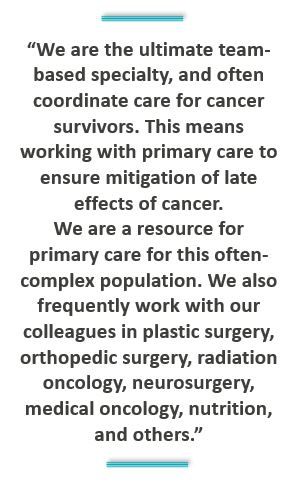- Clinical Technology
- Adult Immunization
- Hepatology
- Pediatric Immunization
- Screening
- Psychiatry
- Allergy
- Women's Health
- Cardiology
- Pediatrics
- Dermatology
- Endocrinology
- Pain Management
- Gastroenterology
- Infectious Disease
- Obesity Medicine
- Rheumatology
- Nephrology
- Neurology
- Pulmonology
Breast Cancer Rehab and Primary Care, with PM&R Specialist Sean Smith, MD
Mortality rates among women with breast cancer have declined steadily for many years allowing tens of thousands of women to lead healthy engaged lives after treatment. Return to the best possible state of health—physically and emotionally—is not without challenge, however, and breast cancer survivors rely on a multidisciplinary team of health care providers to support their return to optimal function.
A woman’s primary care clinician is integral to this team and plays an essential role in post-treatment care and surveillance.

One of the key team relationships for the primary care clinician during breast cancer rehabilitation is with the physical and rehabilitation medicine specialist working with the patient to ameliorate the effects of surgery, radiation, chemotherapy, and other modes of treatment.
Patient Care asked physiatrist Dr Sean Smith to talk about the importance of the relationship between physical and rehabilitation medicine (PM&R), and primary care as a patient progresses through recovery.
Dr Smith is clinical associate professor in the Department of Physical Medicine and Rehabilitation at the University of Michigan /Michigan Medicine, in Ann Arbor, MI, and a member of the American Academy of Physical Medicine and Rehabilitation.
Patient Care: Would you offer a short primer on the focus of cancer rehabilitation in general and then more specifically on the role of physical medicine and rehabilitation (PM&R) in this area?
Sean Smith, MD: Cancer rehabilitation medicine is a specialty within PM&R that focuses on people with a history of cancer to improve quality of life and restore function. This often includes managing musculoskeletal, neurologic, and cognitive issues that are a result of the cancer or its treatment. Our job is to build a relationship with a patient to understand what their needs are, and then determine how we can help them attain their goals. This involves precisely diagnosing the problem – be it pain, restricted range of motion, muscle spasms, weakness, cognitive problems, or a wide range of others. In addition to taking a detailed history and performing a thorough physical exam, we often run additional tests to give us an accurate diagnosis. Once we have that, our treatment typically involves a combination of exercises, medications, interventional procedures, referrals to skilled therapy (eg, physical therapy, lymphedema therapy), orthotic prescriptions (eg, bracing), and/or providing education about their condition and lifestyle modifications to avoid exacerbation.

PC: What other specialties is PM&R most likely to engage with while working with a cancer patient? How is primary care typically involved?
Smith: We are the ultimate team-based specialty, and often coordinate care for cancer survivors. This means working with primary care to ensure mitigation of late effects of cancer (eg, avoiding a sedentary lifestyle and clearing patients who received anthracycline chemotherapy for exercise). We are a resource for primary care for this often complex population. We also frequently work with our colleagues in plastic surgery, orthopedic surgery, radiation oncology, neurosurgery, medical oncology, nutrition, and others. .
PC: Turning to breast cancer specifically, would you describe some of the general and the more common goals of the rehabilitation work you do with women?
Smith: Breast cancer survivors make up about 40% of outpatient cancer rehabilitation medicine clinics nationwide. There are several reasons for the large proportion: the population of breast cancer survivors is very large, patients with stage IV disease often live a long time with disease and experience functional decline through treatment, and there is a significant need for attention to the myriad neurologic and musculoskeletal issues that come with cancer treatment.
Many patients experience post-mastectomy pain syndrome (note that a mastectomy is not necessarily required to experience this), musculoskeletal effects of radiation and long-term endocrine therapy (eg, aromatase inhibitors), chemotherapy-induced peripheral neuropathy, physical deconditioning, pain due to metastatic disease, and cognitive problems due to chemotherapy.
Each problem requires a tailored approach to a patient’s unique needs. For example, a patient with pain after mastectomy and radiation may need a home exercise program, local nerve blocks for pain mediated by now-sensitive nerve endings (neuromas), botulinum toxin injections for muscle spasm and tightness, and more.
PC: What is unique about or specific to breast cancer rehabilitation that primary care physicians should be aware of as they provide ongoing and routine care for their patients post-treatment?
Smith: Rehabilitation is more than simply exercising and returning to work or social roles. Cancer rehabilitation physicians can be a major ally – we can order and interpret tests, prescribe medications, develop patient-centered goals using evidence-based approaches (similar to palliative care, but for rehabilitation), and prescribe home exercises. For patients who need skilled therapy, we can oversee that. For patients who can perform an exercise program on their own but need guidance, we can provide that and save patients co-pays and extra appointments with physical or occupational therapy.
PC: How would you describe the “ideal” relationship or flow of communication during breast cancer rehabilitation between PM&R and primary care – and the patient?
In an ideal world, patients with a history of cancer would be rapidly screened for complex neurologic, musculoskeletal, lymphedema, or cognitive impairments. Those who require care beyond which a primary care provider or, say, a physical therapist, can, would be referred to a cancer rehabilitation PM&R physician.

Unfortunately, such a screening tool does not yet exist. So, I recommend referring any patient who does not improve sufficiently with other interventions, has a diagnostic challenge, or who primary care providers deem as complex and require additional physician input.
PC: What are 3 messages about breast cancer rehabilitation – and Breast Cancer Awareness Month – you would like to close with?
Smith: First: there is an entire medical sub-specialty of physical medicine and rehabilitation, cancer rehabilitation medicine, that are experts on your exact conditions. We see patients with any cancer diagnosis, at any stage, and on any treatment. Utilize us!
Second: cancer rehabilitation services are globally underused despite a high degree of morbidity resulting from cancer treatment. Figure out who in your area provides this care and start sending referrals. Most cancer rehabilitation medicine physicians would be happy to provide an in-service or otherwise chat about the wide range of services offered.
Finally: patients love cancer rehabilitation. For many, it’s the first time since their diagnosis that they get a sense of control over their body, their health. Establishing a patient with a cancer rehabilitation physician may set a patient up for long-term healthy habits and to maximize their function and quality of life.
